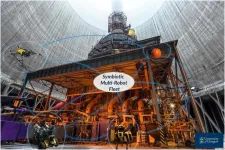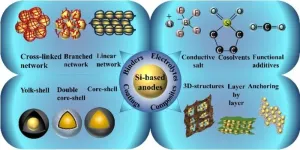(Press-News.org) Nuclear facilities, particularly during decommissioning, face significant challenges due to hazardous materials and environments. Traditional methods often rely heavily on human intervention, posing risks and inefficiencies. A groundbreaking research introduces a symbiotic autonomous robot ecosystem, designed to transform nuclear facility decommissioning. This innovative approach leverages a Cyber-Physical System (CPS) coordinated through a digital twin interface, significantly enhancing safety, efficiency, and operational awareness in high-risk environments.
In a recently published study (https://ietresearch.onlinelibrary.wiley.com/doi/10.1049/csy2.12103) in the journal Institution of Engineering and Technology (IET) Cyber-systems and Robotics, a team of researchers has developed a novel approach to nuclear facility decommissioning using a fleet of robots that work together in a symbiotic relationship. The research introduces a novel implementation of a CPS in a simulated nuclear environment. This system integrates a multi-robot (MR) team, controlled by an operator using a digital twin interface. The project showcases the effective collaboration of autonomous robots within the Symbiotic Multi-Robot Fleet (SMuRF), transcending the boundaries of individual robot capabilities. SMuRF is engineered as a cohesive unit of robots, each with distinct functions, autonomously operating in nuclear environments. The fleet's strength lies in its diversity; for instance, a smaller, agile robot can deftly maneuver through confined spaces, while its larger counterpart is adept at transporting heavy equipment. This synergy allows the robots to tackle a variety of challenges and efficiently complete tasks, illustrating the power of collaborative robotics.
Key features of this system include:
- Symbiotic Autonomy: Robots work in unison, sharing tasks and data, enabling a comprehensive approach to radiation characterization.
- Digital Twin Interface: Operators can oversee and interact with the robot fleet remotely, ensuring safety and efficiency.
- Scalable Autonomy: The system is adaptable, capable of handling a range of tasks and environments.
"This breakthrough represents a paradigm shift in nuclear decommissioning," said Dr. Daniel Mitchell, corresponding author of the study. "By integrating advanced robotics with digital twin technology, we're not just enhancing safety; we're also accelerating the decommissioning process, reducing costs, and setting a new standard in the industry."
The research holds significant implications across various aspects. It leads to enhanced safety by minimizing human exposure to hazardous conditions, crucial in nuclear decommissioning. The approach accelerates the decommissioning process, which can result in substantial cost savings. The technology also has potential applications in other high-risk industries, demonstrating its versatility and broad applicability. This innovation lays the groundwork for the development of more advanced and sophisticated autonomous robotic systems, capable of operating in challenging environments.
###
References
DOI
10.1049/csy2.12103
Original Source URL
https://doi.org/10.1049/csy2.12103
About IET Cyber-Systems and Robotics
IET Cyber-Systems and Robotics is a Gold Open Access journal co-published by the Institution of Engineering and Technology (IET) and Zhejiang University Press that publishes novel research and survey articles in the broad areas of cyber-systems and robotics, with an emphasis on artificial intelligent systems enabled by advanced electronics and modern information technologies. The journal has been indexed by ESCI, EI Compendex, Scopus, Inspec, DOAJ, etc.
END
Symbiotic autonomous robot ecosystem enhances safety and efficiency on nuclear facilities decommissioning
2024-01-31
ELSE PRESS RELEASES FROM THIS DATE:
Alleviate the drought in the east Hungarian plains
2024-01-31
Intensive agricultural cultivation and the resulting changes in soil structure cause low humidity in the near-surface air during heat waves in really dry years. As a result, summer cold fronts roar across the Plain without the usual thunderstorms and precipitation, researchers at the Institute of Geography and Earth Sciences at Eötvös Loránd University explain in a review of articles on topics ranging from geodynamics to soil science to meteorology what made the summer of 2022 so severe in the eastern part of the country.
In 2022, the 7-week period starting in mid-June was disastrous for eastern Hungary. Almost no rain fell for weeks, and in the eastern part of the country, ...
Researchers overview recent progress and challenges in silicon-based anode materials for lithium-ion batteries
2024-01-31
Research in recent years displays that several chemical modifications (binders, composite materials, and electrolytes) provide superior stability and enhance electrochemical performance in Si-based anodes in lithium-ion batteries (LIBs). Thus far, several different chemical interactions on structural alterations to Si-based anode materials have been tried to enhance Li+ kinetics, structural stability, and volume development control throughout the delithiation/lithiation process.
Despite significant advancements, Si and Si-based electrodes are still in their infancy and are still far from finding widespread practical use. Si-based anodes face some difficulties, including substantial ...
News on drug-induced skin swelling
2024-01-31
Angiotensin-converting enzyme inhibitors - ACE inhibitors for short - are effective antihypertensive drugs. They block the formation of the hormone angiotensin II, which plays a central role in the development of high blood pressure. On the other hand, these drugs increase the concentration of the vasoactive signaling substance bradykinin. Among other things, this can lead to acute swelling of the skin or mucous membranes. In general, such swellings are not life-threatening. However, if they affect the tongue, throat or larynx, angioedema can be life-threatening for the patient due to the potential risk of suffocation. Research to date suggests that susceptibility to such drug-induced angioedema ...
Innovation on the design, construction, and experiments of OMEGA-based SSPS prototype: The Sun-Chasing Project
2024-01-31
Space solar power satellite (SSPS) is a tremendous energy system that collects and converts solar power to electric power in space, and then transmits the electric power to earth, spacecraft, or moving targets via microwave. It is regarded as one of the most potential ways to solve the problem of energy crisis.
In 2022, a team of researchers from Xidian University in China has completed a full-link and full-system ground demonstration and verification system for an SSPS, named the Sun-Chasing Project. Their study, recently published in Engineering, introduces the design concept of OMEGA 2.0 SSPS, the related key technologies, and the development of ground demonstration ...
SCAI publishes expert consensus statement on management of calcified coronary lesions requiring intervention
2024-01-31
WASHINGTON—Coronary artery calcification is increasing in prevalence, leading to greater risks both during procedures such as percutaneous coronary intervention (PCI) and adverse events in the short and long term. Along with these challenges, treatment options are expanding, increasingly including calcium modification prior to stent implantation. A newly published SCAI Expert Consensus Statement on the Management of Calcified Coronary Lesions outlines methods for interventional cardiologists to identify various types of calcified coronary lesions ...
Firing nerve fibers in the brain are supplied with energy on demand
2024-01-31
Brain function depends on the swift movement of electrical signals along axons, the long extensions of nerve cells that connect billions of brain cells. The nerve fibers are insulated by a fatty layer called myelin, which is produced by specialized cells called oligodendrocytes. These cells wrap around and insulate nerve fibers ensuring the rapid and efficient transmission of signals that is essential for brain function.
Oligodendrocytes sense and respond to the electrical signals
Now, a team of neuroscientists led by Aiman Saab at the Institute of Pharmacology and Toxicology at the University ...
Engineering viruses to kill deadly pathogens
2024-01-31
Northwestern University researchers have successfully coaxed a deadly pathogen to destroy itself from the inside out.
In the new study, researchers modified DNA from a bacteriophage or “phage,” a type of virus that infects and replicates inside of bacteria. Then, the research team put the DNA inside Pseudomonas aeruginosa (P. aeruginosa), a deadly bacterium that is also highly resistant to antibiotics. Once inside the bacterium, the DNA bypassed the pathogen’s defense mechanisms ...
NIH study shows higher mortality rates for patients on respiratory support in rural intermediate care units
2024-01-31
NIH study shows higher mortality rates for patients on respiratory support in rural intermediate care units
Findings highlight the importance of providing ICU-level care to rural patients with respiratory failure
A new National Institutes of Health-supported study finds that patients receiving ventilator life support in the intermediate care units – a potentially less costly alternative for people not sick enough for the intensive care units (ICUs) but too ill for the general ward – of rural hospitals had significantly higher death rates than patients in the same type of ...
Perspective paper explores the debate over sentient machines
2024-01-31
A researcher from the New Jersey Institute of Technology has published a perspective paper that examines sentience and its application to artificial intelligence (AI) and robotics. Sentience describes the ability to sense and feel, drawing its meaning from the Latin word sentire which means “to feel.” The paper addresses a set of ideological commitments at stake in debates over sentient machines. The author proposes that artificial sentience is both necessary and impossible.
The perspective paper is published in the Journal of Social Computing on December 31, 2023.
“I argue ...
New AI technique significantly boosts Medicare fraud detection
2024-01-31
Medicare is sporadically compromised by fraudulent insurance claims. These illicit activities often go undetected, allowing full-time criminals and unscrupulous health providers to exploit weaknesses in the system. Last year, the estimated annual fraud topped $100 billion according to the National Health Care Anti-Fraud Association, but it is likely much higher.
Traditionally, to detect Medicare fraud, a limited number of auditors, or investigators, are responsible for manually inspecting thousands of claims, but only have enough time to look for very specific patterns indicating suspicious behaviors. Moreover, there are not enough ...








